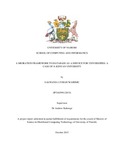| dc.description.abstract | Educational establishments continue to seek opportunities to rationalize they way they manage
their resources. Innovation is necessary to ride the inevitable tide of change and one such hot
recent area in Information Technology is cloud computing. Cloud computing is distributed cloud
technology offering required software and hardware through internet. Due to the growing need of
infrastructure, educational establishments have to spend a large amount of money on their
infrastructure to fulfill the needs and demands of the users. The objective of this study was to
design a database as a service migration framework for universities, taking into consideration
Kenyan universities. The specific objectives were:- to explore the use of cloud computing in
institutes of higher learning; examine the state of art of cloud computing in Kenyan universities;
examine the readiness of Kenyan universities to adopt database as a service; examine the current
cloud data migration frameworks and propose a cloud data migration framework for Kenyan
universities. The study adopted descriptive research design. The study was done in four
universities particularly in Information Communication Technology (ICT) department of each
university. The target population was 200 ICT staff; the sample size of 24 respondents was used
in the study.
Data collection was done through questionnaires and semi structured interviews. Quantitative
data was analyzed using descriptive analysis and presented through bar charts and pie charts.
Thematic analysis was used to analyze qualitative data. The findings showed that institutions
with population of above 40000 were more likely to adopt cutting edge cloud computing
solutions than those with less population since they were found to be more innovative than the
rest. The study concludes that institutes of higher learning in Kenya are ready to adopt database
as a service though this will depend on the size of the institution.
The study also concludes that the proposed framework will be very useful for universities during
migration of their data in cloud because the framework is vendor and technology-independent
and it ensures that institutional security constraints are achieved during and after migration. The
study further concludes that the proposed migration framework will play a great role in
standardizing cloud computing technology and contribute to the technology maturing since there
is no other vendor-technology independent framework for database migration. This work will be
of great importance for educational establishments in Kenya as they seek to implement cutting
edge cloud computing solutions. It will also be of importance to academic research as it will add
literature on migrating database to cloud.
Key words: Cloud Computing, Database-as-a-service, Migration Framework, Educational
establishments, Cloud data | en_US |

